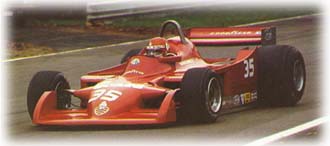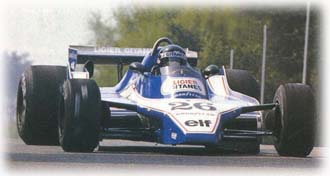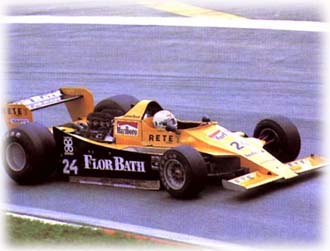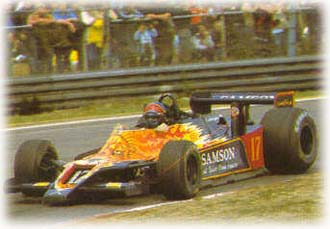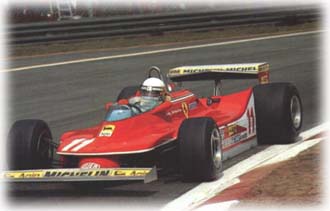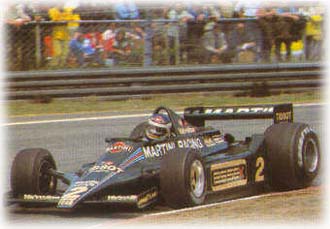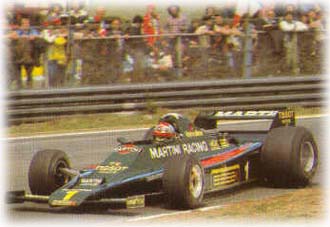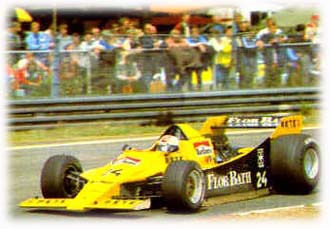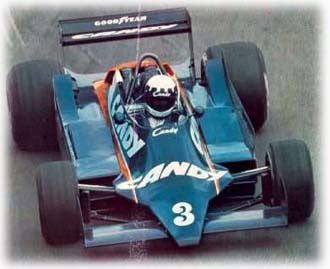| ATLAS F1 Volume 6, Issue 34 | |||
 |
A Race to Remember | ||
| by Marcel Schot, Netherlands | |||
|
Every Grand Prix Venue has its most remembered race; that race where the mighty gods of Formula One diced and dodged to achieve eternal greatness and set the record books straight. But every Grand Prix venue also has remarkable races that were pushed aside in the history books, for no good reason. Atlas F1 writer Marcel Schot reviews, ahead of every Grand Prix this season, one race which should be memorised and valued; that one round in history which makes a Race to Remember
However, the race we remember this week wasn't held at Spa. The 1979 Belgian Grand Prix was held at the Zolder circuit. After the original Spa was deemed too dangerous, Nivelles became the new home, only to be replaced by Zolder for 1973, and from 1975 onwards.
Before the race
Coming to Zolder, the championship was a five man battle. Ligier's Patrick Depailler and Ferrari driver Gilles Villeneuve were in the lead with 20 points. Right behind them, with 18 points, were Depailler's teammate Jacques Laffite and Lotus pilot Carlos Reutemann, whose services were not required at Ferrari anymore after the 1978 season. Ferrari's star driver Jody Scheckter was fifth with 16 points.
While Villeneuve's show in the rain didn't bring him any official results, it certainly helped the Canadian in the first timed session. At the end of the session, now on an almost dry track, Villeneuve was on provisional pole with a time of 1:24.06. Behind the Ferrari driver was a close group of six drivers, who qualified within two tenths of a second. Renault driver Jean-Pierre Jabouille set the second time, four tenths slower than Gilles, closely followed by Jacques Laffite, Williams driver Clay Regazzoni, World Champion Mario Andretti in the Lotus, Gilles teammate Jody Scheckter and the first Brabham of Niki Lauda.
Championship co-leader Depailler had a terrible session, only able to post a time of 1:27.47, over three seconds slower than Villeneuve, the Ligier driver finding himself in 17th position after day one. Another championship contender who wasn't too happy was Carlos Reutemann. The Argentine was better off than Depailler, but 12th place wasn't exactly what he was looking for.
On the back of the grid, drivers were battling for spots as only 24 of the 28 drivers would be allowed to start the race. Clear exits were Gianfranco Brancatelli (Kauhsen) and Derek Daly (Ensign) who were five and three seconds respectively away from a spot in the race. McLaren's Patrick Tambay and Arturo Merzario, driving for his own team, were the other two on the wrong side of the line after the first day of practice.
With the weather improving, the first day of practice proved to be of no relevance at all. Even though Villeneuve improved his time by two seconds, the Michelin tyres simply weren't able to compete with the Goodyears in qualifying. Villeneuve dropped back to sixth, just ahead of Scheckter. The number two of the first session, Jabouille, dropped back much further. The Renault suffered even more on the Michelins, putting Jabouille into 17th, while his teammate Rene Arnoux was 18th.
The race
When race day arrived, the weather had made a complete turnaround from the initial rain. It was warm and sunny as the cars lined up on the grid just before three o'clock. Jacques Laffite got away badly, handing the first corner lead to his teammate. As the drivers came round for the first time, Depailler was leading, closely followed by Alan Jones, Nelson Piquet and Laffite.
Regazzoni braked hard to avoid a collision, but he wasn't thinking about the other Ferrari behind him. Villeneuve hit the Williams in the back, flying high across Regazzoni. The Ferrari landed with all parts still more or less on it, but the Williams driver was less lucky. While Gilles drove back to the pits to get his car in full battle gear again, Regazzoni was confined to a walk back to the paddock.
While Villeneuve resumed in last place, the battle for the lead continued. Depailler was still leading, but by no means easily. Jones, Piquet and Laffite were following close behind, while Scheckter battled Andretti behind them. Scheckter, after Villeneuve's pitstop the only Ferrari left with a chance of winning, was driving like hell. This resulted in the South African taking care of Andretti and Piquet in consecutive laps. Piquet was less than happy with Scheckter, since the Ferrari had nudged him slightly during the overtaking manoeuvre.
After 13 laps, the first mechanical problems hit the drivers. Privateer Hector Rebaque and Renault's Jean-Pierre Jabouille had to end their race early with a broken driveshaft and a failing turbo respectively. While Villeneuve was on his way up, Jochen Mass retired when he spun off the track after 17 laps. Meanwhile, Laffite had passed Jones to make it Ligier one and two again. After 18 laps it still was Ligier one and two, but the order was reversed.
Shortly after Laffite had moved into the lead, a little war among two Italians raged at the back. Elio de Angelis and Bruno Giacomelli were battling for position when the former drove into the latter in an attempt to pass the Alfa Romeo. Both cars were out on the spot. While Laffite and Depailler were fending off Jones and Scheckter, the hot weather exerted its toll on the cars. Within two laps, Arnoux and both Brabhams were sidelined, the Frenchman with a broken turbo and the Brabhams both with blown engines.
Now Depailler was back in the lead, followed by Laffite, Scheckter, Didier Pironi in the Tyrrell and Riccardo Patrese who was surprisingly fast in the Arrows. Behind Patrese, a small dot rapidly grew larger, developing into Gilles Villeneuve's number 12 Ferrari. By now, both Ligiers were suffering badly from worn tyres. Leader Depailler became the first victim, simply understeering off the track on lap 47. Laffite was able to keep the lead for a few more laps, but his fate was sealed. By now, Villeneuve had overcome Patrese and was hunting down Pironi, who was some 15 seconds ahead of him in third.
However, Gilles wasn't happy with less than the absolute maximum, so he went in hot pursuit of Laffite's Ligier, which was an impossible 20 seconds ahead. As Scheckter secured his first win for Ferrari, Villeneuve closed in on Laffite at an alarming pace. The gap shrunk from 20 seconds to 18 to 15 to 11 seconds with five laps remaining. Laffite was giving it everything he had on his completely worn Goodyears, but Villeneuve kept closing in at a rate of two seconds a lap.
After 69 laps, Scheckter was comfortably leading as Laffite blasted past the start/finish line with the red devil on his heels. However, the devil's car didn't sound the same as the previous 68 times it had passed. When the 70th and final lap was nearly completed, the problem hit Villeneuve like a sledgehammer. He had pursued one goal too many. His frantic chase for second position had used all the fuel in his fuel tank. Instead of third, Gilles was rewarded with a walk back to the pits.
Conclusion
This was an absolutely stunning race. The battle for the lead was a continuous one for 60 of the 70 laps, until worn Goodyears took away Laffite's chance of winning. The drama was also present from the first until the last lap. From Villeneuve's collision with Regazzoni, until his heroic chase ended in tears with no fuel left. Two times the race leader retired, to provide more drama. Scheckter wanted this win badly, since the public opinion was already that even though the South African was the number one driver, Villeneuve was clearly faster than him.
After Zolder, the Championship table was thrown all over the place. Scheckter was now leading the dance with 25, Laffite closely following with one point less. Carlos Reutemann also moved past Depailler and Villeneuve with his fourth place, putting him on 21, while the other two remained on 20 points.
|
| Marcel Schot | © 2000 Kaizar.Com, Incorporated. |
| Send comments to: schot@atlasf1.com | Terms & Conditions |
